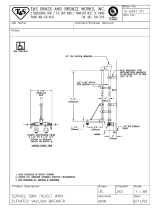
GENERAL INSTRUCTIONS
(INSTALLATION for 64C/86CRPW)
Note: Read the following instructions carefully. Proper installation of your Jackson
Dishwasher will assure proper machine operation.
1. Open the front doors and hook open. Remove dish, cup, and glass racks and set aside for later
use. Remove the tape holding the overflow tubes, the pump intake strainers, and the wash and
recirculating rinse tubes that are in the machine.
2. Cut the straps holding the machine to the base of the crate. Ease the machine on to the floor and
slide into place of installation.
3. Remove the plug provided on either end of the drain plumbing (whichever side is convenient), and
connect the drain (2" female IPS) with the proper slope to conform with local and/or national
codes. Drain is a gravity feed system from the machine.
4. Connect incoming 1/2" water line with capacity to supply 3.8 gallons per minute at 20 PSI flow
pressure and at a temperature of 180°F minimum. For the 86CRPW, another 1/2" water line must
be connected to the pre-wash section to supply 140°F. These connections are just before the Y-
strainer on top of the machine. Make connections to conform to local and/or national codes.
5. Electrical connections should be made through the hole in the back of the control box to the
terminal board on the back right-hand side. This terminal board is accessible by removing the
control box cover. The terminals are marked L1, L2 (single-phase), or L1, L2, L3 (three phase).
Be sure all connections conform to local and/or national codes. Refer to data plate for voltage and
amperage totals.
6. DO NOT APPLY POWER UNTIL STEP 9!!!!
7. Make sure drains are closed and the curtains are in place. The long curtains go on the outside of
the vent cowls. The short curtains go on the inside of the vent cowls. A medium curtain goes
between the pre-wash and wash tanks. A long curtain goes between the wash and recirculating
rinse tanks. A short curtain goes between the recirculating rinse and final rinse.
8. Turn lever operated drains (if so equipped) to the closed position. Turn on hand valves controlling
water supply to machine. Check for any leaks in the plumbing.
9. To energize electrically, proceed as follows:
a. Turn on customer's circuit breaker controlling the machine.
b. Check voltage at the incoming terminals L1, L2, and L3 (if applicable). It should match the
data plate voltage. Voltage at L1 and L2 should be checked to ground individually to ensure
that a high (or wild) leg is not connected to L1 or L2.
c. If voltages are in the required range, turn on the 20-amp circuit breaker. The 20-amp circuit
breaker protects the control circuits only; it is not meant to protect the wash and recirculating
rinse heaters or motors.
10. a. Turn fill handle(s) on the top of the machine to supply the unit with water. When the required
level is reached, turn the fill handle(s) back to the original position. Open the doors and check
the water level. It should be within 1/4" below the overflow level.
b. If unit is equipped with the Auto-Fill option, fill by turning on the power switch and pushing and
releasing the Auto-Fill Switch. (Warning: If unit does not continue to fill when switch is
released, immediately turn power switch off. Clean probes located in wash tank [and pre-
wash, if 86CRPW] and try again. If problem persists, call service agency.) Fill will shut off
automatically when proper level is reached.
11. When the water has reached the proper level, close the doors and turn on the power switch. The
heaters are in the wash and recirculating rinse tanks. They are utilized to maintain the wash water
temperature at 150°F, and the recirculating rinse water temperature at 160°F.
12. Turn the manual switch on by pushing and releasing the momentary side of the switch. This will
activate a hold circuit and the pumps, conveyor, and final rinse will come on and run continuously.
Turn manual switch off.
13. Turn the auto switch on by pushing and releasing the momentary side of the switch. This will
activate a hold circuit, but nothing will come on until a rack is inserted into the machine. Insert rack
into the soiled side of the machine. The pumps, conveyor, and final rinse will come on. Allow the
rack to travel all the way through the unit. The pumps, conveyor, and final rinse will shut off
automatically when the rack leaves the unit.
8





























